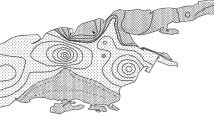Abstract
The results of studying the hydrocarbon composition of organogenic bottom sediments of oil-polluted lakes and lakes of similar types remote from centers of anthropogenic activity are given. To correctly assess the oil pollution of organogenic materials one has to take into account the presence of native hydrocarbons in their composition and to choose the main criterion of oil pollution based on the presence of specific oil components not characteristic of aquatic ecosystems in their natural state. The most promising among such components are alkylbenzenes С15–С25, which slowly degrade under the conditions typical of northern aquatic ecosystems and can be retained for a long time by organogenic matrix.
Similar content being viewed by others
References
Atlas Khanty-Mansiiskogo avtonomnogo okruga. Priroda. Ekologiya (Atlas of Khanty-Mansi Autonomous Area: Nature, Ecology), Khanty-Mansiisk, 2004, vol. II.
Brodskii, E.S., Butkova, O.L., Shelepchikov, A.A., and Feshin, D.B., Identification of oil spill sources in soil and bottom sediments by gas chromatography–massspectrometry, Mass-Spektrom., 2010, no. 7, vol. 2, pp. 139–146.
Burmistrova, T.I., Alekseeva, T.P., Perfil’eva, V.D., et al., Biodegradation of oil and oil products in soil with the use of ameliorants based on activated peat, Neft Gaz, 2004, no. 4, pp. 99–102.
Glyaznetsova, Yu.S., Chalaya, O.N., Zueva, I.N., and Lifshits, S.Kh., Environmental monitoring and reclamation of oil-polluted soils in the Arctic zone of Yakutia, Arktika Sever, 2012, no. 5, pp. 97–108.
GOST (State Standard) 17.1.4.01–80: Nature Protection. Hydrosphere. General Requirements to Methods for Determining Oil Products in Natural and Waste Waters. http://standartgost.ru/g/?OCT_17.1.4.01-80. Assessed October 6, 2015.
Drugov, Yu.S., Ekologicheskie analizy pri razlivakh nefti i nefteproduktov. Prakticheskoe rukovodstvo (Environmental Analyses in the Case of Oil and Oil-Product Spills: Practical Guide), Moscow: BINOM, Laboratoriya znanii, 2007.
Duchko, M.A., Gulaya, E.V., and Serebrennikova, O.V., Assessing the effect of anthropogenic factors on the composition of peat bituminous components in the southern West Siberia by data on hydrocarbon composition, in Desyatoe sibirskoe soveshchanie po klimatoekologicheskomu monitoringu (Tenth Siberian Conference on Climate–Environmental Monitoring), Tomsk: Agraf-Press, 2013, pp. 207–209.
Znamenshchikov, A.N., Determining the structural–group composition and total hydrocarbon concentrations in oil and oil pollution by spectral methods, Extended Abstract of Cand. Sci. (Chem.) Dissertation, Tyumen: Tyumen State Univ., 2012.
Zueva, I.N., Kashirtsev, V.A., Lifshits, S.Kh., et al., Methods for studying surface hydrocarbon geochemical fields of natural and technogenic origin, Nauka Obraz., 2009, no. 1, pp. 50–54.
Ivanov, K.E., and Novikova, S.M., Bolota Zapadnoi Sibiri, ikh stroenie i gidrologicheskii rezhim (Bogs in West Siberia, Their Structure and Hydrological Regime), Leningrad: Gidtometeoizdat, 1976.
Ivanova, I.K., Monoalkylbenzenes in oils of Vendian–Cambrian deposits, Electronic Scientific Journal Neftegazovoe Delo, 2008, no. 1, pp. 1–22, http:// ogbus.ru/authors/Ivanova/Ivanova_1.pdf. (Accessed May 5, 2015).
Il’ina, I.S., Lapshina, E.I., and Lavrenko, N.N., Rastitel’nyi pokrov Zapadno-Sibirskoi ravniny (Vegetation Cover of West-Siberian Plain), Novosibirsk: Nauka, 1985.
Kurakolova, E.A. and Burkova, V.N., PAC as markers of natural and anthropogenic HC flows into modern sediments, Materialy konf. “Khimiya nefti i gaza” (Proc. Conf. “Oil and Gas Chemistry”), Tomsk, 2003, pp. 95–98.
Kursheva, A.V., Aromatic hydrocarbons as an estimation criterion of the consequences of emergencies at subaqual oil-and-gas-production facilities: case study of Pechora Sea water area, Cand. Sci. (Chem) Dissertation, St. Petersburg: VNIIOkeangeologiya, 2006.
Moskovchenko, D.V., Purtov, V.A., and Zav’yalova, I.V., Hydrochemical characteristic of watersheds in Khanty-Mansi Autonomous Area, Landshaftov. Geokhim., 2008, no. 8, pp. 141–148.
Nikanorov, A.M. and Stradomskaya, A.G., Problemy neftyanogo zagryazneniya presnovodnykh ekosistem (Problems of Oil Pollution of Freshwater Ecosystems), Rostov-on-Don: NOK, 2008.
Perechen’ metodik, vnesennykh v reestr metodik kolichestvennogo khimicheskogo analyza (List of Procedures Registered as Procedures of Quantitative Chemical Analysis), part II, FTsAO, Rosprirodnadzor. http://fcao.ru/metodiki-kkha/2-uncategorised/114-perechnimetodik-vklyuchennykh-v-reestr-pnd-f.html. (Accessed September 5, 2015).
Petrov, A.A., Uglevodorody nefti (Oil Hydrocarbons), Moscow: Nauka, 1984.
PND F 16.1:2.2.22-98. Kolichestvennyi khimicheskii analiz pochv. Metodika vypolneniya izmerenii massovoi doli nefteproduktov v mineral’nykh, organogennykh, organno-mineral’nykh pochvakh i donnykh otlozheniyakh metodom IK-spektrometrii (Quantitative Chemical Analysis of Soils. Procedure for Measuring the Mass Fraction of Oil Products in Mineral, Organogenic, Organic–Mineral Soils, and Bottom Sediments by IRSpectrometry Method), Moscow: Gos. kom. RF po okhrane okruzhayushchei sredy, 2005.
Serebrennikova, O.V., Preis, Yu.S., Kadychagov, P.B., and Gulaya, E.V., Composition of hydrocarbons in peat organic matter in southern West Siberia, Khim. Tverd. Topl., 2010, no. 5, pp. 40–50.
Yudina, N.V. and Savel’eva, A.V., Hydrocarbons in peat-forming plants at eutrophic bogs in Western Siberia, Geochem. Int., 2008, no. 1, pp. 77–84.
Medeiros, M.P., Bicego, C.M., Castelao Menezes, R., et al., Natural and anthropogenic hydrocarbon inputs to sediments of Patos Lagoon Estuary, Brazil, Environ. Int., 2005, no. 31, pp. 77–87.
Gao, X. and Chen, S., Petroleum pollution in surface sediments of Day Bay, South China, revealed by chemical fingerprinting of aliphatic and alicyclic hydrocarbons, Estuarian, Coastal and Shelf Sci., 2008, no. 80, pp. 95–102.
Author information
Authors and Affiliations
Corresponding author
Additional information
Original Russian Text © M.G. Kul’kov, E.A. Zarov, I.V. Filippov, 2017, published in Vodnye Resursy, 2017, Vol. 44, No. 2, pp. 191–200.
Rights and permissions
About this article
Cite this article
Kul’kov, M.G., Zarov, E.A. & Filippov, I.V. The choice of oil-pollution criteria for organogenic bottom sediments by chromatography-mass-spectrometry. Water Resour 44, 267–275 (2017). https://doi.org/10.1134/S0097807817020063
Received:
Published:
Issue Date:
DOI: https://doi.org/10.1134/S0097807817020063




